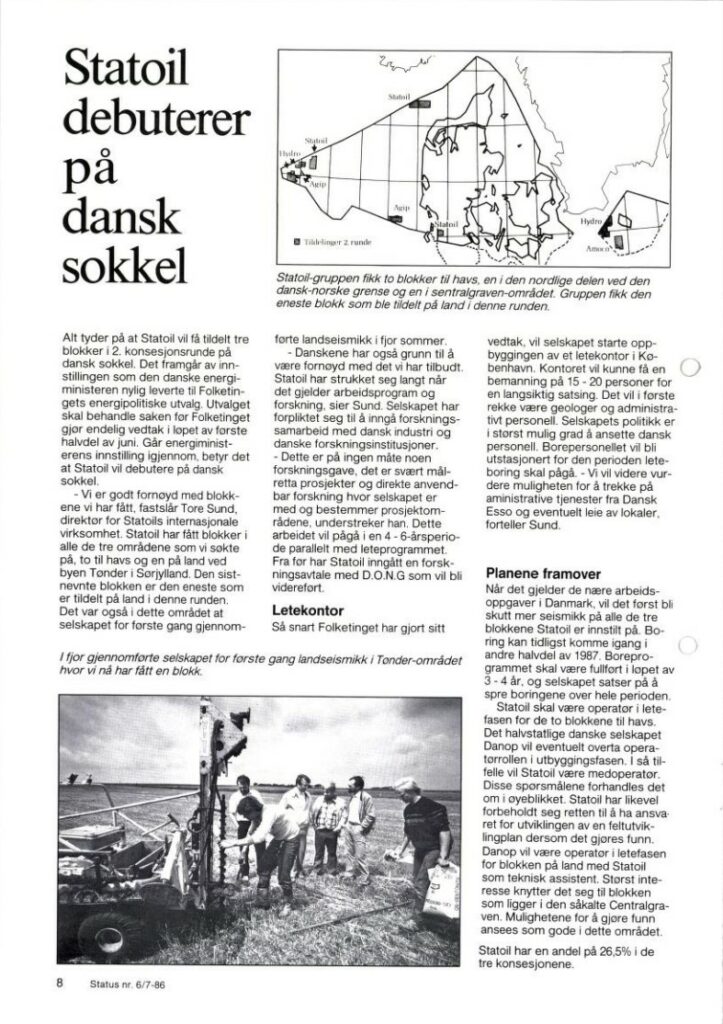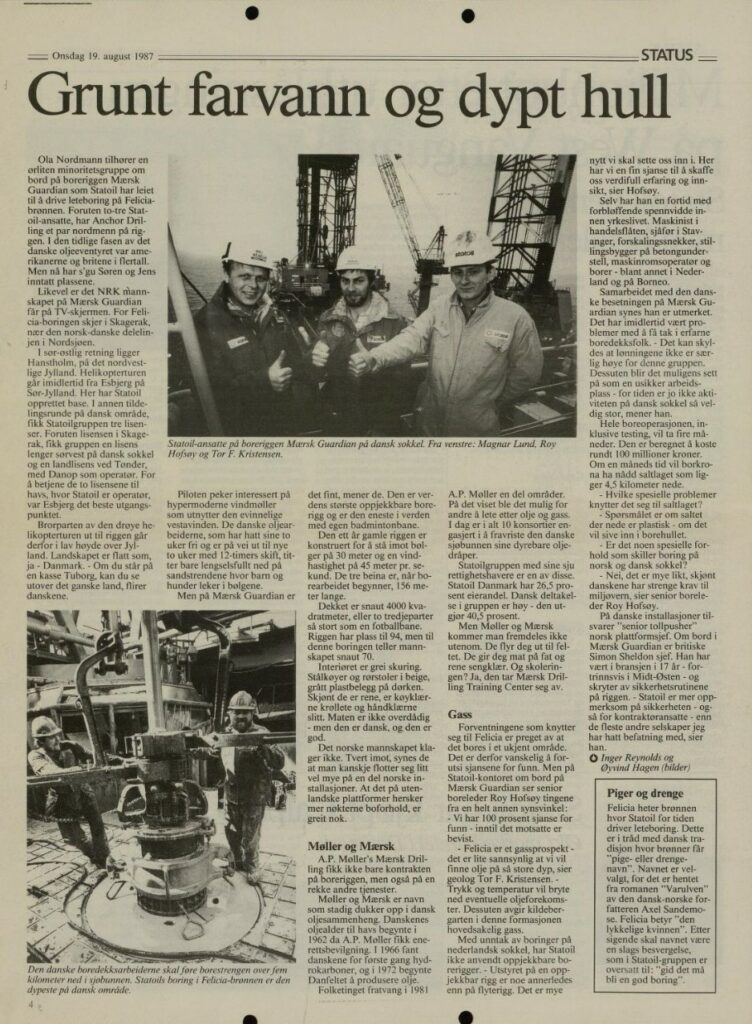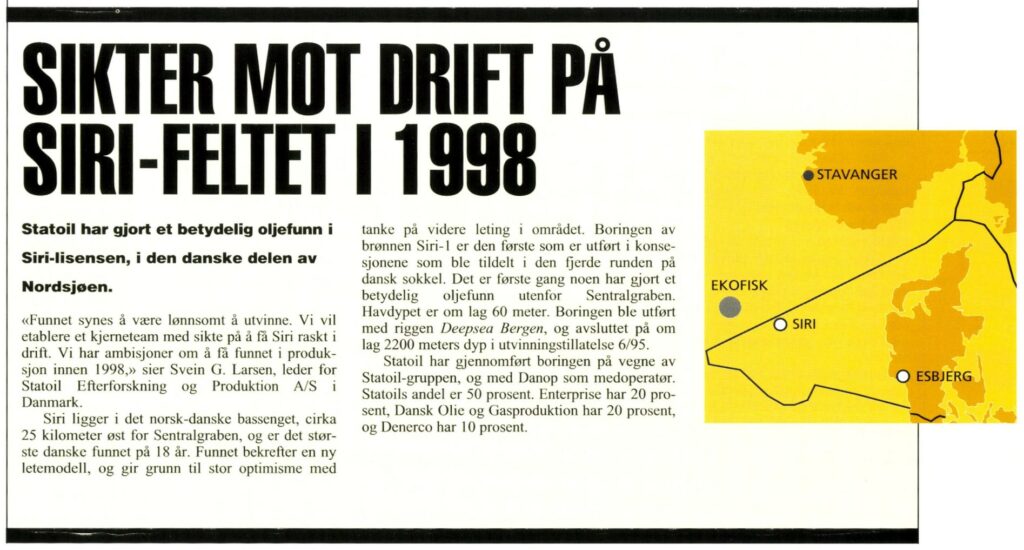A tasty Danish – but not lasting

A request to participate in the first Danish offshore licensing round, due to take place in 1982, was submitted by the company to the Ministry of Petroleum and Energy. But the Storting had determined in 1981 that Statoil’s foreign involvement should be confined to certain licences on the Dutch continental shelf and consultancy support in China.[REMOVE]Fotnote: Recommendation no 93 (1981-82) to the Storting from the standing committee on energy and industry, Om Den norske stats oljeselskap A/S, selskapets plan for virksomheten i 1982, årsberetning og regnskap for 1980 og melding om virksomheten i første halvår 1981. The company’s own board, on the other hand, believed it had sufficient experience and capacity to take on assignments in other countries. Statoil had also received a growing number of approaches on collaboration from various foreign oil companies, and expected to participate in production outside Norway.[REMOVE]Fotnote: Recommendation no 97 (1983-84) to the Storting from the standing committee on energy and industry, Om Den norske stats oljeselskap A/S, selskapets plan for virksomheten i 1984, årsberetning og regnskap for 1982 og melding om virksomheten i første halvår 1983.
The majority on the Storting’s energy and industry committee, comprising the Conservatives and Christian Democrats, nevertheless turned down the request. They did not believe Statoil should become involved abroad, whether in exploration and production, processing or other industrial activity. The minority, comprising the Labour Party, had no objection to a foreign commitment – without that affecting the result. So Denmark’s first licensing round came and went without Norwegian involvement.
Danish oil history kicks off

Denmark was already an oil producer even before an initial licensing round took place. Exploration on the Danish continental shelf (DCS) had begun at the same time as on the NCS, with the first discovery made as early as 1966. That was a year before Balder was discovered in the Norwegian North Sea. The Danes were so late in starting to award licences because the A P Møller industrial group had secured a sole concession for the whole DCS until 2042. But the politicians changed their mind in 1980 and cancelled the monopoly the following year when the Folketing (parliament) rescinded a number of the Møller group’s privileges.
When preparations began for a second Danish round in 1985, the Storting had also changed its mind and Statoil was allowed to apply for licences abroad. Together with two Danish partners – the Cost-of-Living Allowance Fund (which had its roots in Denmark’s union movement) and EAS Energy A/S, a subsidiary of the East Asiatic Company – as well as Australia’s Broken Hill Propriety Petroleum and Norway’s Skeie group from Kristiansand, the company secured two licences on the DCS and one on land. It was also given the significant job of building up Danop, the Danish oil company owned 50-50 by the state and the newly established Danerco.[REMOVE]Fotnote: Status, no 11, 1985.
Initial exploration in Denmark

Even before the licensing round, Statoil had conducted its first Danish seismic surveys on land. These took place north of the town of Tønder, a few kilometres inside the border with Germany.[REMOVE]Fotnote: Status, “Landseismikk for første gang”, no 8, 1985.
The company spudded its first offshore well on the DCS on 1 July 1987 in what was known as the Skagerrak licence. It thereby ranked as the first international oil company to drill in the Danish North Sea. This Felicia well was located in the Norwegian-Danish Basin.
A thick and extensive layer of salt deposited 250 million years ago lies almost 5 000 metres beneath the sea, covering an ancient desert. Statoil regarded this formation as interesting, with the porous sandstone providing an excellent reservoir for oil and gas while the salt formed an impenetrable cap rock. But the company also know that the chances of a discovery were small, and it failed to find petroleum there.[REMOVE]Fotnote: Status, no 5, 1987, see the accompanying map.
Exploration drilling began the following year in the Central Graben. All DCS discoveries have been made in or within the immediate vicinity of this area. A well extending no less than 5 556 metres – the longest drilled off Denmark until then – found oil, condensate and gas. Named Amelia, this also ranked as Statoil’s first significant discovery outside the NCS. The field was developed.
The company then secured the Lulita area through an additional licensing round in 1990. A small discovery made there was declared commercial in 1994.
Siri discovered

Statoil applied for further exploration acreage in January 1995 during Denmark’s fourth round. This represented a final attempt to make a big discovery on the DCS before a possible winding-down of efforts there.[REMOVE]Fotnote: Statoil Magazine, no 4, vol 18, 1996. The company now wanted to try out a completely new exploration area – the Ringkøbing-Fyn High just outside the Central Graben, and secured the acreage it had applied for. This included block 5604/20 – the Siri field.
Just before Christmas 1995, Statoil made an encouraging discovery. Siri ranked as the biggest find made on the DCS over the previous 18 years, and the company’s largest anywhere in 1995. Just over three years later, on 1 March 1999, Statoil brought Siri on stream and the first cargo of oil was shipped to the Mongstad refinery in western Norway on 11 April 1999.[REMOVE]Fotnote: Annual report, 1999, Statoil.
Siri was the first DCS field to be brought on stream by a foreign operator, and the first outside the Central Graben. With an average daily output of about 50 000 barrels per day, it accounts in 2022 for about a fifth of Denmark’s overall oil production. Statoil has won high praise from the Danish government for its execution of the project.
After a decade on the DCS, Statoil had made three commercial discoveries – the Amalie gas field and the Lulita and Siri oil fields.
But Statoil was only operator for the exploration and development phases, and Danish oil company Dong took over when production began in 1999. Without its own operatorships, Statoil sold all its exploration and production activities on the DCS to Dong in 2002.[REMOVE]Fotnote: Annual report, 2002, Statoil.
arrow_backUSA – the world’s largest energy marketArve Johnsen’s departurearrow_forward